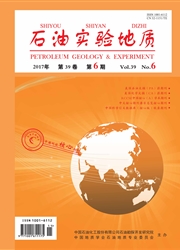

 中文摘要:
中文摘要:
根据干酪根生烃过程中的体积变化,讨论了渤海湾盆地东营凹陷沙三下亚段和沙四上亚段泥页岩生烃演化对储集空间的贡献。研究认为,东营凹陷这2套泥页岩具有较高的脆性矿物含量,2 000~3 000 m是泥页岩岩石力学性质发生明显转变的阶段,岩石脆性变大,在3 000 m以下,有机孔隙保存条件较好。在此基础上计算2套不同丰度泥页岩在不同埋深条件下的有机储集空间的大小。结果表明,有机质丰度较低(TOC含量小于2.0%)的泥页岩,生烃次生孔隙非常有限,而高丰度烃源岩(TOC含量大于4.0%),在演化程度较高的条件下生烃转化能形成4%以上的次生孔隙。东营凹陷沙四上亚段埋藏较深,演化程度较高,在深洼处具有较丰富的生烃次生孔隙;而沙三下亚段总体演化程度不高,其生烃产生的次生孔隙仅局部地区发育。
 英文摘要:
英文摘要:
The contribution of hydrocarbon conversion to reservoir space of the shale in the lower Es3 and the upper Es4 in the Dongying Sag of the Bohai Bay Basin is discussed according to the volume change of kerogen in the process of hydrocarbon generation. It is proposed that the two sets of shale is of high brittle mineral content, and the mechanic property of the shale changes obviously in the depth intervals of 2 000-3 000 m and the shale becomes more brittle. There are good preservation conditions for pores within organic matter below 3 000 m, and the porosities within organic matter of the two sets of shale with different organic matter abundance in different buried depth are further discussed. It is shown that the porosities within organic matter are very limited for the shale with low abundance of organic matter ( TOC content 〈 2% ) ; however, for the shale with higher abundance of organic matter (TOC content 〉 4% ), the porosities formed during hydrocarbon generation process can reach 4% in the higher mature stage. In the Dongying Sag, the upper Es4 section has a higher maturity, and the poros- ities within organic matter are widely developed during hydrocarbon generation in the deep depression. For com- parison, it has a much lower organic maturity and porosity, and only locally developed in the lower Es3.
 同期刊论文项目
同期刊论文项目
 同项目期刊论文
同项目期刊论文
 期刊信息
期刊信息
